
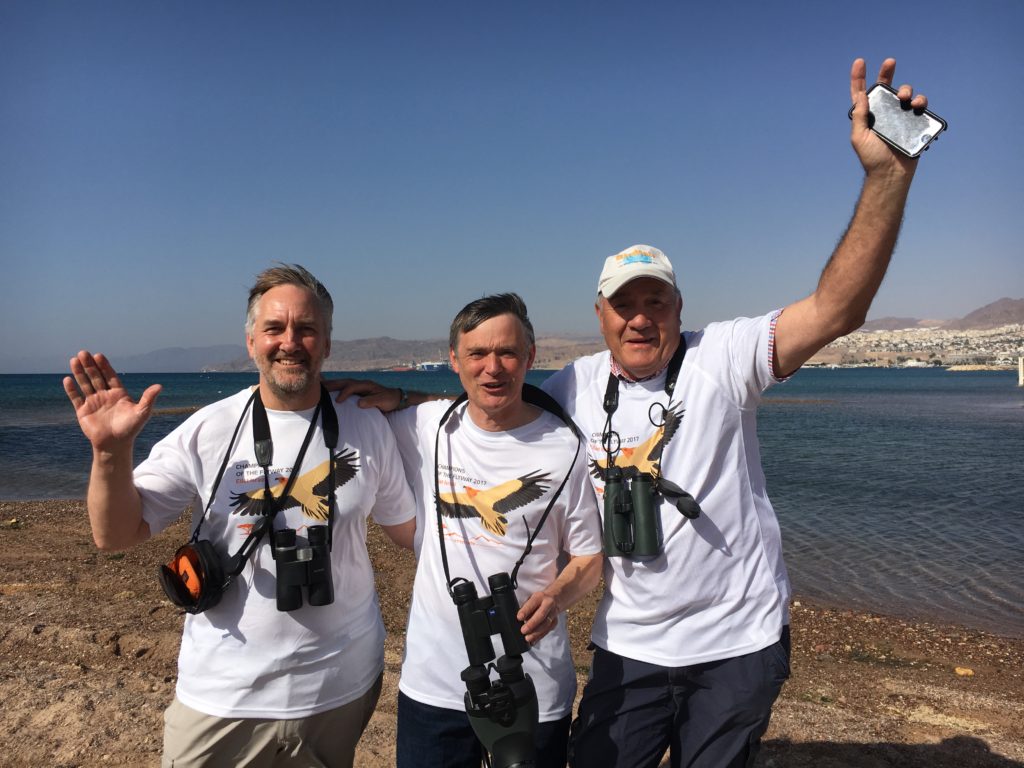
The Media Birders 2017 team. Andy Swash (left), Dominic Couzens (middle), Tim Appleton (right).
This year I was fortunate enough to take part in the annual Champions of the Flyway international Bird Race in Israel. 34 teams from around the world assembled to compete in a 24-hour Bird Race on Tuesday 28th March, seeing who could see and hear the most species in a 24 hour period in a defined part of Southern Israel, beginning and ending in Eilat, on the Gulf of Aqaba on the Red Sea.
The following is a detailed account of our race day. It is written to thank our many sponsors and supporters for their help.
The reason behind Champions of the Flyway is to raise money to try to put a stop to the widespread illegal slaughter of migrant birds on the eastern Mediterranean flyway. Incredibly, more than 20 million birds are shot or trapped in various countries along the flyway every year. In 2017 the money raised will go to Birdlife International’s partner in Turkey, Doğa Derneği (Birdlife in Turkey) so that they may focus on halting the illegal killing of birds on migration. For more information see http://www.champions-of-the-flyway.com/
RACE DAY – THE MEDIA BIRDERS
04.20 – We meet in the lobby of the Agamim Hotel, the starting point for all teams. Birdrace Organisers Dan and Jonathan are there and tell us that most other people are already out – have we blown this already with a late start? Ten minutes earlier a Common Whitethroat had struck the lobby windows, but had recovered from the blow and was released. That delay has cost us; we missed it and didn’t see another all day.
Downtown Eilat (04.30-04.45)
We go into the night of southern Israel; downtown Eilat is our first destination, where there is a roost of White-eyed Gulls by a shopping mall. A House Crow calls and the House Sparrows are well awake, but we cannot see the gulls. Let’s hope this starts to go better…
Then a Striated Heron calls out of the darkness. That’s a good bird.
1- House Crow 2- House Sparrow 3- Striated Heron
Kibbutz Eilot (04.55-05.10)
It is a short drive to the Kibbutz Eilot, where we hope to hear a Scops Owl. A short stroll there reveals nothing at all.
We drive towards the Bird Park, but before entering venture a little along the dirt track towards kilometre 19. A Crested Lark sings a few notes, but nothing else. No owls appear or call.
4- Crested Lark
Eilat Bird Park (05.15-06.50)
Back at the Bird Park, it is still dark. To be honest, I expected to see quite a few teams to be starting here, but in the event, there are only a handful of cars. We gear up with torches, because the trails are used by vipers at night, apparently. A snake bite would bring our bird race to an abrupt end.
A few birds are calling in the loaming, and these fortunately include a Scops Owl. Near the end of the track, however, we hear a low call and add a very tricky species to our tally, a Little Bittern. We wonder if any other teams will record this species. The flamingos feeding on the saltpans are visible in silhouette in front of the colourful hotel lights.
5- Black-winged Stilt 6- Eurasian Scops Owl 7- Moorhen 8- Greater Flamingo 9- Black-crowned Night Heron 10- Spur-winged Lapwing 11- Little Bittern 12- Collared Dove
As we walk unhurriedly around the Bird Park, a few species begin to call, including several that could have been problematic later in the day. A Water Rail squeals, a Stone Curlew can just be made out in the distance and a Common Nightingale utters a few liquid notes before thinking better of it.
13- Water Rail 14- Stone Curlew 15- Ringed Plover 16- Spanish Sparrow 17- Spectacled Bulbul 18- Common Nightingale 19- Grey Heron 20- Slender-billed Gull 21- Laughing Dove 22- Lesser Whitethroat 23- Reed Warbler
It seems to get light very quickly here in southern Israel. Birds that were shapes in the gloaming are suddenly identifiable. From the Anita Hide we make out Ruff and Little Stint, while a Wood Sandpiper is practically feeding at our feet. By now several other teams have arrived here and the small hide is jam-packed with fellow bird-racers. Being of small stature I am having some difficulty seeing over heads, while both Andy and Tim tick off Yellow Wagtail and Little Grebe. I didn’t manage to see Little Grebe until 12 hours later, but this doesn’t matter because, according to the rules, only two of the three members in our team need to hear or see any particular species. The air above the lake is thick with swallows, looking like giant gnats above the reedbeds. A Little Bittern shows for just about everybody.
The next few minutes bring us a flurry of new species. Some of these are particularly “needed” here, removing the need to rush back this evening: several Penduline Tits are calling, at least three Little Crakes are in the opposite reed bed and a White-throated Kingfisher uses a pipe as a post. On the other hand, two species that were easy to see here last night, Temminck’s Stint and Broad-billed Sandpiper, are mysteriously absent.
24- Ruff 25- Little Stint 26- Wood Sandpiper 27- Barn Swallow 28- Little Ringed Plover 29- Penduline Tit 30- Little Grebe 31- Red-rumped Swallow 32- White-throated Kingfisher 33- Sedge Warbler 34- Little Crake 35- Yellow Wagtail 36- Marsh Sandpiper 37- Graceful Prinia
The flurry continues, but at least it is light enough to see what I am scribbling without using a torch. Amongst the many easy species, several stand out: two Grey Plovers on the flats, easy to miss here; a delightful male Bluethroat hopping on the grass like a muscular robin, and several Heuglin’s Gulls over. The rest are easy picks, but of course every species counts the same.
38- White Wagtail 39- Common Sandpiper 40- Common Swift 41- Bluethroat 42- Common Redshank 43- Grey Plover 44- Greenshank 45- Marsh Harrier 46- Heuglin’s Gull 47- Dunlin 48- Purple Heron 49- Chiffchaff 50- Eastern Bonelli’s Warbler 51- Rock Dove/Feral Pigeon 52- Sand Martin 53- Blackcap 54- Ring-necked Parakeet 55- Hoopoe
Holland Park, Eilat (07.00-07.45)
It is fully light now and we have seen all the species that we hoped at this site, apart from the two waders mentioned earlier. Our plan is to head for Holland Park, a patch of scrub on the north-west side of Eilat, which is excellent for migrants and breeding birds alike. This visit will be crucial for our success, because we know that several species will be much easier to find here than anywhere else on our itinerary. For example, over the last few days the blooms on a flowering Caper bush have been bickered over by several Rüppell’s Warblers, making them easy to find. But they are migrants, and might have moved on.
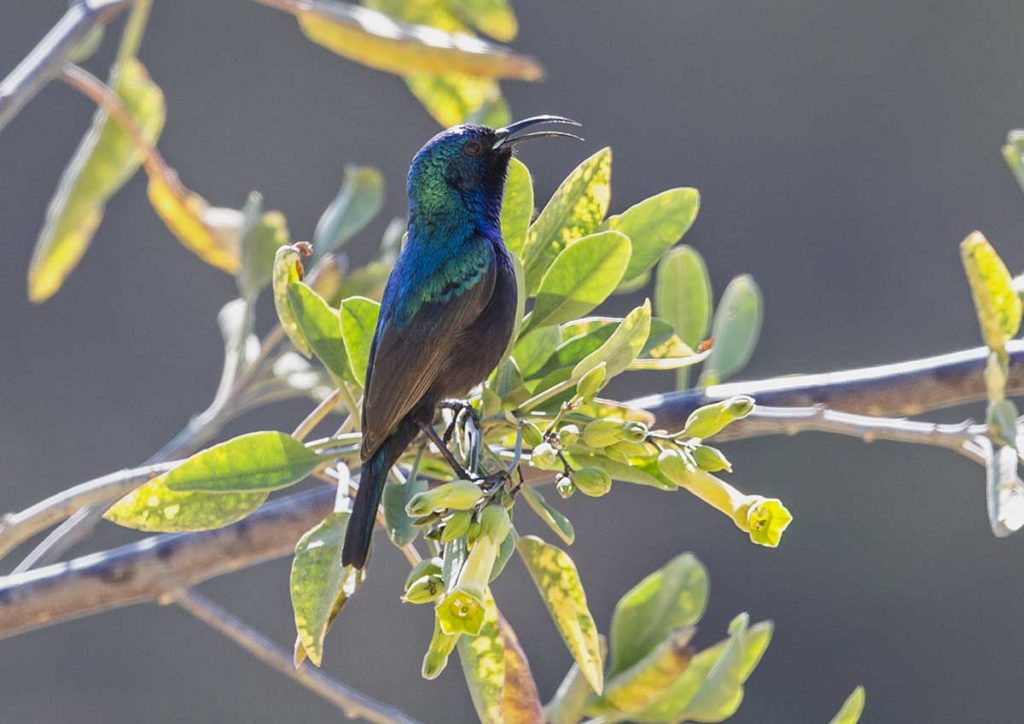
Nectarinia-osea-Palestine-Sunbird-Male_051A3500-c-Andy-and-Gill-Swash-WorldWildlifeImages.com
They haven’t. Several Rüppell’s Warblers are still at it, at the same place, and the scrub is alive with birds. We even re-find a Savi’s Warbler at a small, dense patch of greenery where there was a tiny pool four days ago. The next few minutes brings a purple patch, everything we hoped for and more. They come from all directions: one moment brings a Wryneck on the ground a few metres ahead, then an Eastern Orphean Warbler darts from the scrub, there is a call from another birder that an Alpine Swift is flying overhead, and finally we make out the shape of a Sand Partridge on the small hill in front of us. Cretzschmar’s Buntings and Trumpeter Finches are feeding at a small pool. This is great stuff.
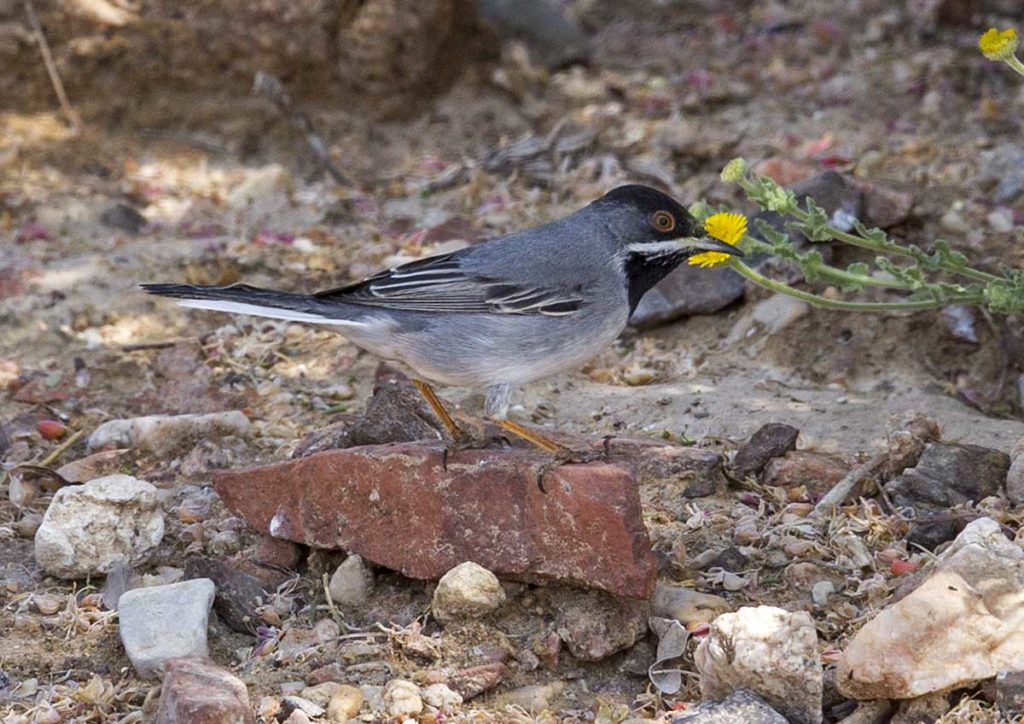
Sylvia rueppelli (Ruppell’s Warbler) Male (c) Andy and Gill Swash (WorldWildlifeImages.com)
As we leave we luck into three more big bonuses. A Garden Warbler appears in a bush ahead (very early for here), a Barbary Falcon flies past as we open the car doors and then, another early migrant, a Hobby shoots along the skyline.
That was 45 minutes of bliss!
56- Savi’s Warbler 57- Rüppell’s Warbler 58- Arabian Babbler 59- Palestine Sunbird 60- Cretzschmar’s Bunting 61- Wryneck 62- Eastern Orphean Warbler 63- Alpine Swift 64- Sand Partridge 65- Subalpine Warbler 66- Trumpeter Finch 67- Ortolan Bunting 68- Tristram’s Starling 69- House Martin 70- Pallid Swift 71- Sardinian Warbler 72- Blackstart 73- Garden Warbler 74- Barbary Falcon 75- Hobby
North Beach, Eilat (08.00-08.15)
Holland Park has put an optimistic complexion on our day: after an average start we have now put some terrific species on the board. We now take the first of several risks: most people do North Beach at the end of the day, but we are going to scan this extremity of the Red Sea early morning instead. It could be a dead loss, but then again…
…It certainly isn’t. Immediately there is action as there are terns flying around, the only ones we have seen here all trip, two Commons and a Sandwich. The Reef Egret is still on the sand spit and, after a short while, we locate the three long-staying Greater Sand Plovers. Squinting our eyes towards the huge ships anchored offshore we locate the Tufted Duck flock from yesterday and then, quite unexpectedly, a bird is careening just above the surface – Cory’s Shearwater, amazing! A couple of gulls later we dash back into the car, excited by an excellent suite of difficult species.
76- Little Egret 77- Western Reef Egret 78- Common Tern 79- Greater Sand Plover 80- Glossy Ibis 81- Sandwich Tern 82- Armenian Gull 83- Cory’s Shearwater 84- Tufted Duck 85- Squacco Heron 86- White-eyed Gull 87- Great Cormorant
Eilat Mountains (c.08.30)
The morning’s bonuses of Striated Heron and Little Bittern mean that there is now no reason for us to visit South Beach, saving almost 30 minutes from our schedule. We are now 10 or so minutes ahead as we break north on Route 12 into the mountains. We make a few stops to check for birds of prey, but we need to get to our desert locations early.
88- Brown-necked Raven 89- Steppe Buzzard 90- Black Kite 91- Steppe Eagle
Seifim Plains (09.15-10.00)
We turn off Route 20 and on to the Seifim Plains by 9.15am, and it’s clear there is still much bird activity. And birder activity, too, with several Bird Race teams around. As per the ethos of Champions of the Flyway, nobody is keeping stuff to themselves (everybody is connected via WhatsApp messaging), and we follow directions to some Hoopoe Larks and Temminck’s Horned Larks. These are exciting species, birding royalty, and they seem out of place as ticks on a Bird Race. The same applies to our wheatears: Mourning, Hooded and Desert.
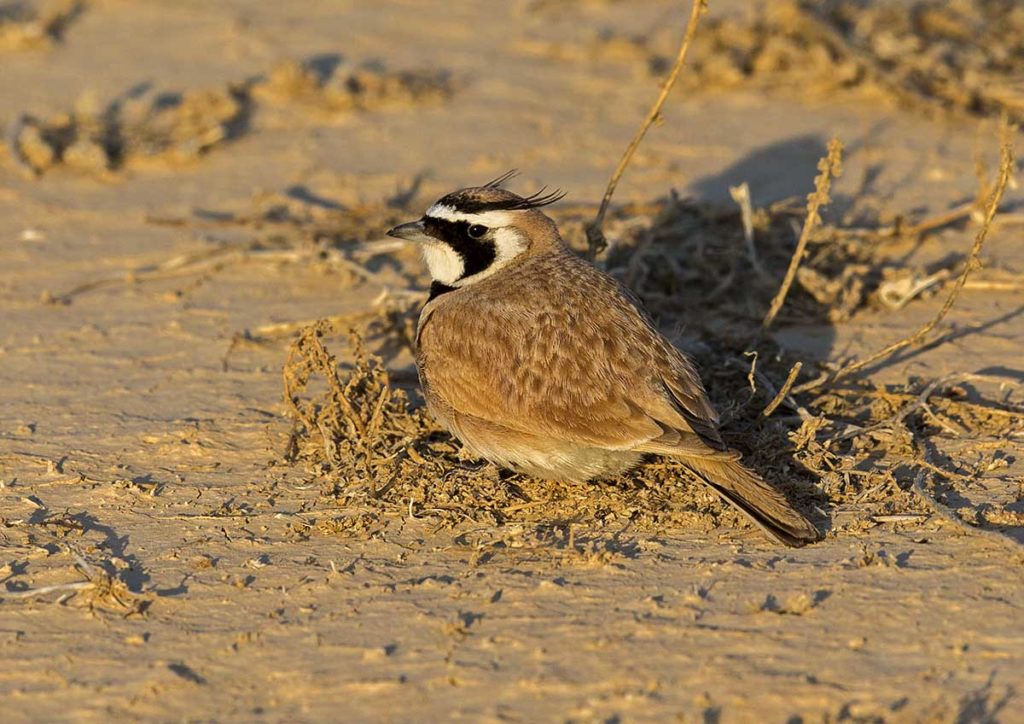
Eremophila bilopha (Temminck’s Lark) Male (c) Andy and Gill Swash (WorldWildlifeImages.com)
We hit our first big frustration of the day. Another team has located an Asian Desert Warbler in the low scrub a few metres away, a bird that isn’t only a good one for the Race list, but a species I have never seen. We miss it by five minutes and it vanishes.
The disappointment doesn’t endure. A call from a bird flying over and we have Tawny Pipit on the list, easily missed. Then some more, slightly House Martin-like calls emanate from a flock of small Passerines passing by, Short-toed Larks. And, wait, there is at least one larger bird with them – classic Bimaculated Lark migratory behaviour. We are getting lucky again.
I become vaguely aware of a plover-like call and draw Andy’s attention. It’s a distant Cream-coloured Courser, seemingly out of sight.
92- Common Kestrel 93- Hoopoe Lark 94- Mourning Wheatear 95- Desert Lark 96- Hooded Wheatear 97- Streaked Scrub-Warbler 98- Tawny Pipit 99- Temminck’s Horned Lark 100- Desert Wheatear 101- Booted Eagle 102- Short-toed Lark 103- Bimaculated Lark 104- Cream-coloured Courser
Route 12 (c.10.00)
With our first desert foray a resounding success, we head north towards our second, and last one, the Uvda Plains. Taking Route 12, we finally run into a White-crowned Black Wheatear by the roadside, a bird that can potentially be missed. Then a few dots appear to our left, near the Egyptian border. We haven’t seen many birds of prey yet so we decide to check these out. There’s an easy stopping place.
It’s southern Israel, it’s March; they’ve got to be Steppe Buzzards, everything is a Steppe Buzzard.
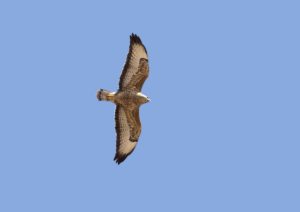
Buteo buteo vulpinus (Common ‘Steppe’ Buzzard) In flight. (c) Andy and Gill Swash (WorldWildlifeImages.com)
Well, one is. Then Tim calls “I have a hawk, it has a long tail!” And then we all realise it has bulging secondaries and a rounded tail. In fact, it’s a classic Northern Goshawk.
But what’s this other one? Clearly an eagle, but what sort of plumage type is this? Then another penny drops. Those contrasting dark secondaries – it’s an immature Eastern Imperial.
Wow! This is getting serious. Both those are tough birds.
“I wouldn’t be surprised if we missed something easy like Short-toed Eagle today,” muses Tim. Unfortunately, his prophecy comes true.
105- White-crowned (Black) Wheatear 106- Northern Goshawk 107 – Eastern Imperial Eagle
Uvda Plains (10.30-11.00)
We don’t have much left to find in terms of desert species, but we are short of a few wheatears. We quickly put that right with a quick scan across these arid plains, which have a curious backdrop of low black basalt hills. We quickly spot a familiar bird, Northern Wheatear and almost immediately its leggy, fast-running relative the Isabelline Wheatear. Izzys look rather like Northerns doing their exercises in the morning. Another scan and a distant male Black-eared comes into view, despite the increasing heat-haze. That was easy.
The Uvda Plains is our sandgrouse stakeout. A couple of days ago we had four Crowned here and about 30 Spotted Sandgrouse. This time we make do with just the sounds of a flock of Spotteds. Again, these exciting desert birds seem too good just to tick. Maybe they should count double?
108- Isabelline Wheatear 109- Northern Wheatear 110- Spotted Sandgrouse 111- Black-eared Wheatear 112- Bar-tailed (Desert) Lark
Neot Smadar junction (11.15-11.20)
We’ve been on the go for seven hours and it is coffee time. We deserve it, and there is a café on our route. As it happens, it’s no ordinary café; it’s an establishment with a long-staying Hume’s Yellow-browed Warbler in the garden. It is only one species, but why not?
“I’ll get the coffee, you see if you can find the bird,” offers Tim. He wanders over to the counter. A few paces take Andy and I to the door to the garden, which we swing open.
“Tshwee-ep!”
The Hume’s calls before we have taken two paces outside. That took less than five seconds.
“I haven’t ordered yet!” says Tim. The coffee tastes wonderful.
113- Hume’s Yellow-browed Warbler
Our strategy takes a radical turn. On previous Champions of the Flyway races, people have tended either to start in the north of the racing area (where you must go to see a suite of extra species) and go south, or they have started south, cleaning up en route and finishing in the north (using the hours of darkness to drive back down to the “finishing line” at the Agamim Hotel.) We are doing something quite different. We have started south, but we are intending to go north during the middle of the day, and then return before it gets dark. That way we can use the relatively unproductive hot hours for travelling.
The advantage of this is that we are leaving a whole set of species (about 20) to clean up towards evening. The disadvantage is that, if we get catastrophically delayed, we might miss them all. It’s a high-stakes gamble.
So we head north on Route 40, with nearly 200km to go to reach our northernmost point. The risk is exhilarating.
Mitzpe Ramon (12.15-12.35)
It’s been nearly an hour since our last species, but as we approach the spectacular clifftop town of Mitzpe Ramon, we pass the site of the carcass that the Bird Race organisers have thoughtfully provided. It is populated by a feeding frenzy of vultures.
114- Eurasian Griffon Vulture 115- Egyptian Vulture
We saw Blue Rock-thrush earlier in the week at the very top of the hairpin-bend road to the town. On this occasion, something catches our eyes a few hundred metres down, and we pull off the roadside. It so happens that it’s a bunting, and since this is a stake-out for Striolated Bunting, we scan the clifftop assiduously. Eventually the bunting comes into view and, moments later, so does a female Blue Rock-thrush, its long “nose” obvious even in silhouette.
116- Pale Crag Martin 117- Striolated Bunting 118- Blue Rock-thrush
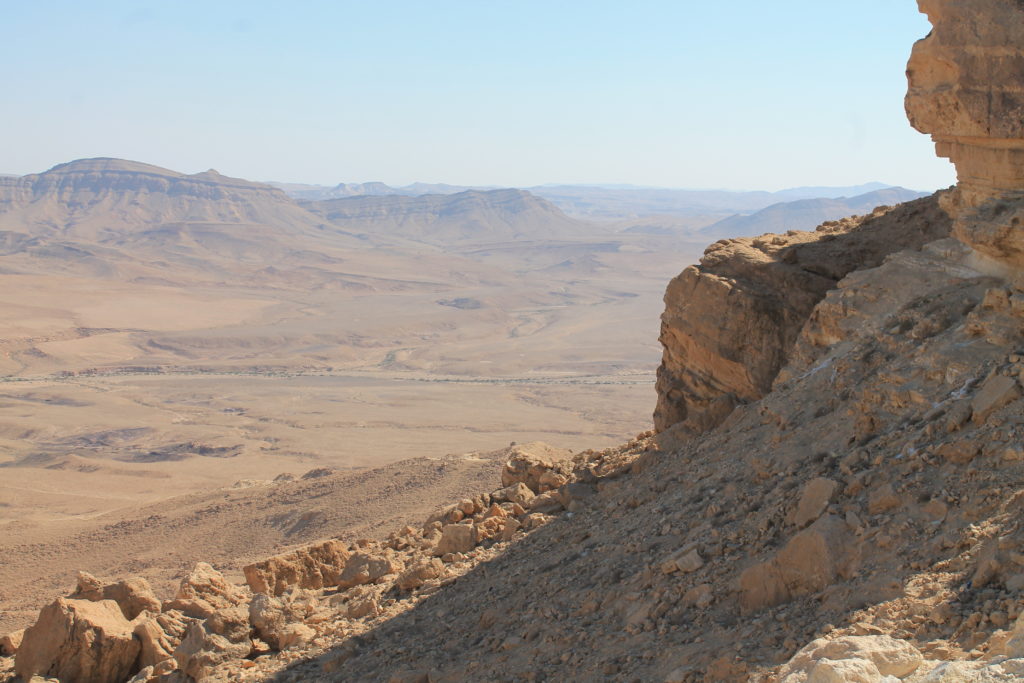
The view from the top of the road up to Mitzpe Ramon
The football pitch in the village is apparently a stakeout for Linnet. I feel somewhat sceptical, for some reason, but when we arrive it is obvious that it is lovingly looked after and is just about the greenest grass in the Negev. Places like this attract migrants and, sure enough, there is a smart Red-throated Pipit in the goalmouth. Another pipit roughly at left midfield is a Tree Pipit and the only crowd noise comes from a pair of Linnets on the touchline. We have scored three goals.
119- Red-throated Pipit 120- Tree Pipit 121- Linnet 122- Hooded Crow
Nafha Prison area, Mitzpe Ramon (12.40-12.45)
Remarkably, we are still on schedule, and there is just a little room for improvisation. Although we didn’t visit it on any of our scouting days, we have heard some good things about the sewage farm next to Nafha Prison (sewage farms generally are priceless for birders). It is a known area for Golden Eagle and other goodies, and even a Menetries’s Warbler has been seen here this week. It must be worth a short stop?
We take a turn too late and find our way to a hillside overlooking the area. We consider trying to turn back, but what’s this? There is a thermal full of White Storks dropping down towards the greenery and, down in the valley, a Long-legged Buzzard patrols. That’s our first of the latter this week.
A soft trill and – would you believe it? – a Desert Finch appears. To see this and Trumpeter Finch on the same day is something special. We seem to have been on a roll ever since Holland Park.
123- White Stork 124- Desert Finch 125- Long-legged Buzzard
We decide to leave the sewage farm behind and strike north again; we still have about an hour to go before we reach Yeroham Lake, our northernmost locality. It is after midday and hot.
Midreshet Ben-Gurian (13.05-13.20)
We are into Southern Grey Shrike territory now, so we scan the wires assiduously as we drive. Quite naturally, these predatory songbirds were everywhere a couple of days ago, but today, on Bird Race day, they are about as conspicuous as quails. But what’s this? A bit large for a shrike. No, it’s much better than that; a very early Roller. Colourful, and a huge bonus.
The gen from WhatsApp suggests that we should call in at the kibbutz at Sde Boker. Birds are falling out of the trees there, and a Collared Flycatcher has been showing all morning, clearly impossible to miss.
We make the short detour and walk for 25 minutes, missing the un-missable flycatcher. And the Robin. And the Song Thrush. There are Blackbirds singing at least, and our first Greenfinch flies over, but if we were on a roll, it ceased with the Roller.
Some more wire scanning does at least secure us Lesser Kestrel just north of town.
126- Roller 127- Blackbird 128- Greenfinch 129- Lesser Kestrel
Yeroham Lake (13.30-14.00)
We have made it to our northernmost point at last. It is a relief. I have good memories of this place from a few days ago – it’s wooded, peaceful and full of birds.
Today it is still wooded, but there also happen to be coachloads of schoolchildren here, and the peace is shattered.
But the need to be here soon becomes obvious. For the first time for hours, there are plenty of easy birds around. Chaffinch, Robin and Great Tit sing or call, while on the reservoir we cannot miss Coots, Mallards and Great Egret. We finally see our first shrike of the day, a finely marked Masked, and the required Purple Swamphen appears on the opposite side of the reservoir.
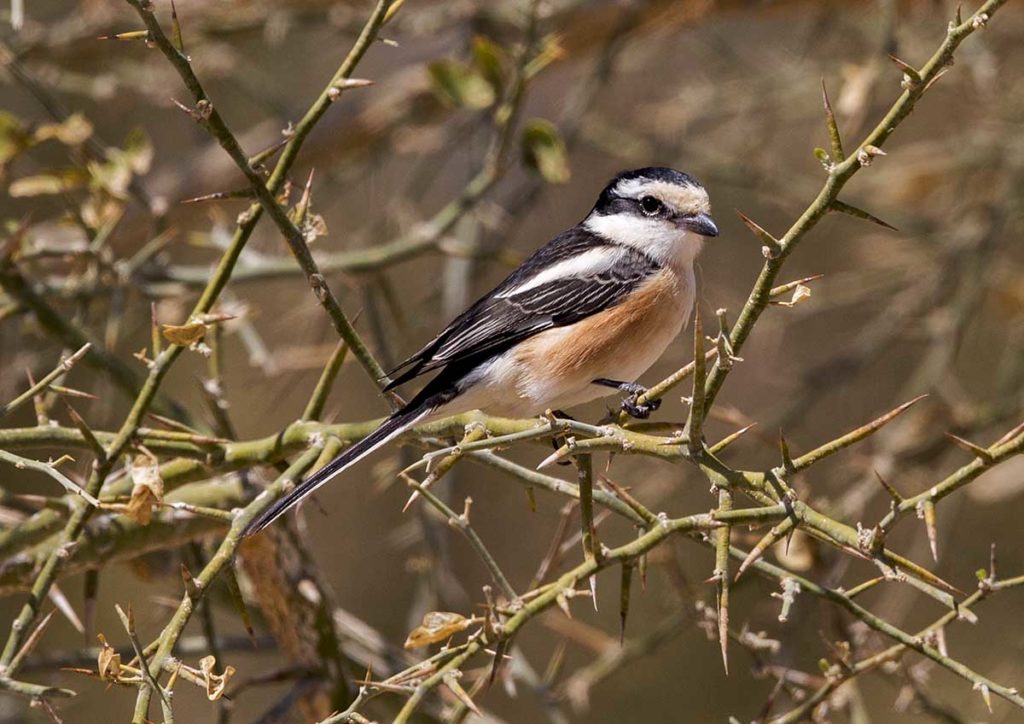
Lanius nubicus (Masked Shrike) 1st-summer male (c) Andy and Gill Swash (WorldWildlifeImages.com)
This is all badly needed, because we have only given ourselves half an hour here.
By the waterside, we strain our ears to hear a distant Cetti’s and a still fainter Great Reed Warbler. There is something still rarer here – lunch. Truly, we actually eat something. Yes, really, a sandwich. During a bird race.
A Syrian Woodpecker calls. At the end of the track, near a dry valley, Andy points.
“It’s a Chukar? Can you hear it?”
“No.”
Andy frowns. I was also struggling with the Great Reed Warbler. I cup my ears, but there’s nothing. This isn’t my finest hour. Tim, our driver, was still scoffing lunch and also misses it.
We simply must head back, time is winning. We try one more time at the beginning of the track, close to the entrance. I decide to run up the hillside. After 50m I stop, look down and see two Chukars. Unbelievable.
130- Robin 131- Great Tit 132- Chaffinch 133- Coot 134- Mallard 135- Great Egret 136- Purple Swamphen 137- Green Sandpiper 138- Masked Shrike 139- Cetti’s Warbler 140- Great Reed Warbler 141- Syrian Woodpecker 142- Chukar
5km north of Mitzpe Ramon (14.45-15.15)
Somewhere on the route back towards Mitzpe Ramon, we finally spot a Southern Grey Shrike on the roadside wires. We now have a decision to make – to crack on south back to within close range of Eilat; to check out the sewage farm by the prison; or to drive west for a few kilometres along Route 171. We found Black-bellied Sandgrouse here a couple of days before, just 10 minutes down the road, as well as Stonechat.
In the event we opt for this last detour. It gets us our only Woodchat Shrike of the day, but the sandgrouse is elsewhere. On our return, we check the cliffs very briefly at Ben Gurian for Lanner, but it doesn’t show and we are beginning to worry about time. We are over half an hour behind schedule.

Oenanthe lugens (Mourning Wheatear) Male (c) Andy and Gill Swash (WorldWildlifeImages.com)
There is now a very long drive back down towards Neot Semadar junction. Fortunately, we have a driver who can out his foot down, Tim (Appleton) Hamilton.
143- Southern Grey Shrike 144- Woodchat Shrike
Shizzafon (16.20-16.30)
By the time we reach the sewage works at Neot Semadar (Shizzafon) it is 16.20, and feels like evening. We don’t linger here, but do pick up two common migrants we have missed earlier. There is no sign of the Namaqua Dove of a few days back, nor the Water Pipit. And where are all the Eastern Olivaceous Warblers? We are beginning to miss stuff – happily, though, we have at least fifteen guaranteed species near Eilat on kilometre 19 and 20 off Route 90. We are now hoping to make 160 or even 170 species.
145- Willow Warbler 146- Common Redstart
Yotvata (17.00-17.15)
At such a good time of day, the half an hour spent getting here seems like a waste. At last, though, we are getting back towards the Eilat hotspots. We are thinking of returning to Yotvata for the evening harrier roost (Pallid, Hen), so we only visit the sewage works here which had Little Green Bee-eater yesterday. We duly see some bee-eaters, but other needed birds we have seen here previously, such as Citrine Wagtail and Sparrowhawk, aren’t around.
147- Little Green Bee-eater
Kilometre 19 (17.45-18.00)
It is now 18.00 and we have only an hour of daylight left – where has it gone? We have two very good hotspots to cover in very little time, and things become seriously frantic. Firstly, we arrive at the freshwater pools at Kilometre 19 with screeching brakes and a puff of dust. A lot of other birders are here and we quickly gather some new species that they have staked out: the old faithful Spotted Redshank that has been here all week; a raft of ducks at the far end; an Osprey flying over and our first and only Cattle Egret of the day. There is no sign of the Egyptian Geese that have been reported.
148- Spotted Redshank 149- Common Teal 150- Pintail 151- Shoveler 152- Osprey 153- Cattle Egret
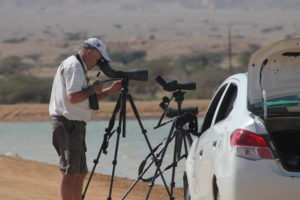
Does Tim look stressed? Trying to find a Broad-billed Sandpiper at km20
Kilometre 20 (18.15-18.45)
Half an hour doesn’t feel nearly long enough for this superb place, but we don’t have a choice. We simply need to track down all the species that we need. Things don’t start well. The small group of waders on the first salt-pan are supposed to contain Broad-billed Sandpiper and Curlew Sandpiper, but despite checking them thoroughly and then checking them again, we cannot locate either. We simply must turn our attention to the rest of the site. Kentish Plover is easy, and so is Shelduck, but it seems to take forever to find anything else. We aren’t panicking, not yet anyway.
We drive half way round the site. The causeway between the pans is packed with birds, as ever, and we manage to pick out some roosting Gull-billed Terns among the Shovelers and other ducks. There is also at least one Black-headed Gull amongst the Slender-billed Gulls, too. Unbeknownst to us there are some Collared Pratincoles among the melee, but we overlook them.
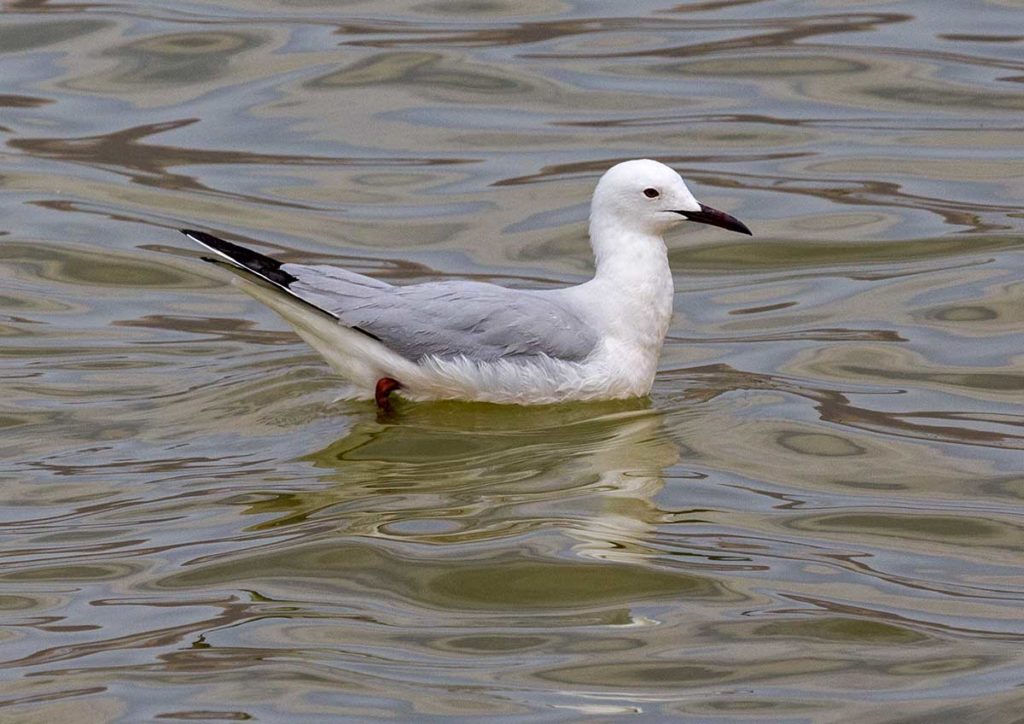
Larus genei (Slender-billed Gull) Adult summer (c) Andy and Gill Swash (WorldWildlifeImages.com)
We scan the open water and eventually locate the two Black-necked Grebes in evening light, and there are a good number of Garganey swimming about. Where, though, are the Avocets and Black-tailed Godwits that we couldn’t possibly miss last night? They were both feeding right up close to the northern shore of the pans, but are missing from there.
The Avocet finally gives itself up much further out in the water, and Andy manages to spot the two Red-necked Phalaropes that have been here for the last day or two; they have relocated to a different part of the pans, too. This is all far too complicated, and where are the godwits? I doubt whether I have paid less attention to Red-necked Phalaropes in my entire life, or appreciated them less. If you were birdwatching in England and ignored a Phalarope in favour of trying to find a godwit, everybody would think you were mad. That is what a Bird Race does.
We turn the very last corner on the circuit and there, looking suitably guilty (or at least it should) is a Black-tailed Godwit.
154- Kentish Plover 155- Shelduck 156- Gull-billed Tern 157- Black-headed Gull 158- Black-necked Grebe 159- Garganey 160- Avocet 161- Red-necked Phalarope 162- Black-tailed Godwit
Eilat Bird Park (19.00-20.00)
We really wanted to go to Yotvata to have a chance of harriers and pipits, but it’s too late to get there and instead we dash back to the Bird Park. Here we might connect with the Temminck’s Stints or, yet again, Broad-billed Sandpipers. In the event, it is clear that they aren’t around. However, from the Anita Hide there is a Pied Kingfisher, in almost exactly the same place that the White-throated Kingfisher sat about 13 hours ago.
We suffer a bad patch. A Common Snipe has been in view while we were watching the kingfisher, but we don’t look for it until it has disappeared into the reedbed. Even more frustratingly, the Arctic Redpolls have located a Mediterranean Gull and, although Andy finds it and says, “Look through my scope” the bird must have chosen that moment to fly off, as all I can see is a bunch of Slender-billed. By now we are more or less chasing Med Gulls by the light of the hotels across the water, such is the gloom.
163- Pied Kingfisher
Yotvata (20.25-20.45)
Strictly speaking, we have four hours of Bird Racing left. The truth is, it is dark and we are delighted with our total of 163, although the last hour has been a little frustrating. We decide to return to Yotvata to look for owls and listen for quail. This last detour ensures that we have covered 400 miles during the day.
We listen, we drive, we follow the headlights. No owls, no quail.
You might think that, after so many hours rushing about, we wouldn’t want to rush any more. But on the other hand, if Tim drives fast enough, we can get back to the Agamim Hotel for dinner.
We do. And the beer tastes like nectar.
Our final total wasn’t enough to win, but we were well-placed (8th). The joint winners were the Arctic Redpolls from Finland and the local team the Wallcreepers (181).
It is still possible to contribute to this excellent cause by sponsoring us at https://www.justgiving.com/fundraising/COTF17-TMB
To date this year’s race has raised over $50,000. Our team has so far raised £2274 – thank you so much.
With thanks to the Israeli Government Tourist Board for making my participation possible.
